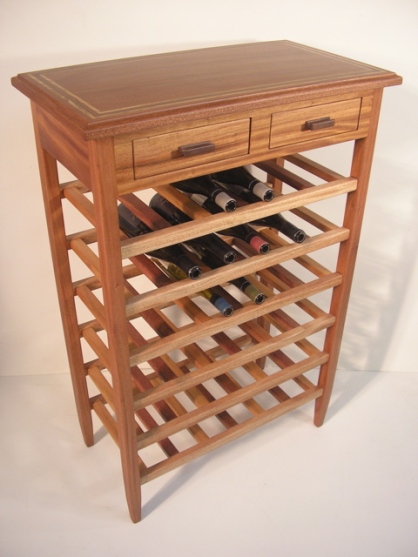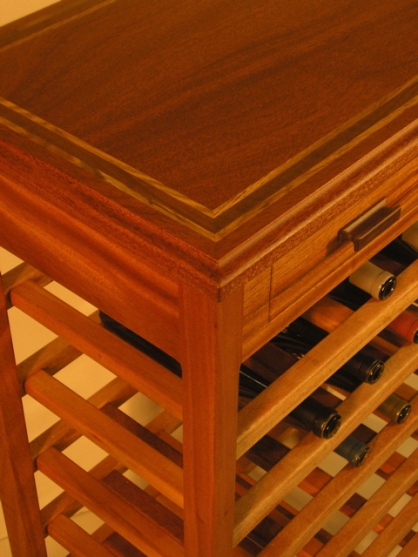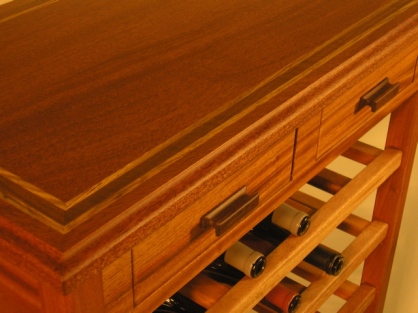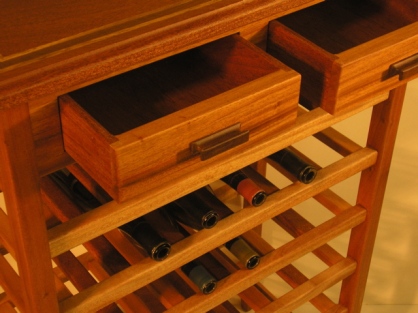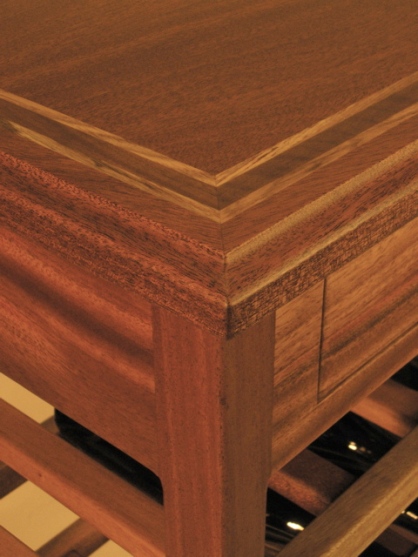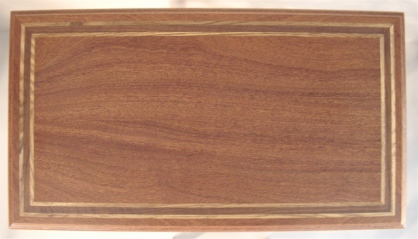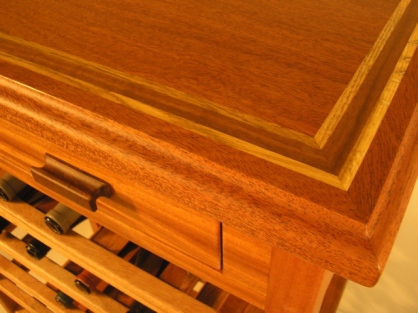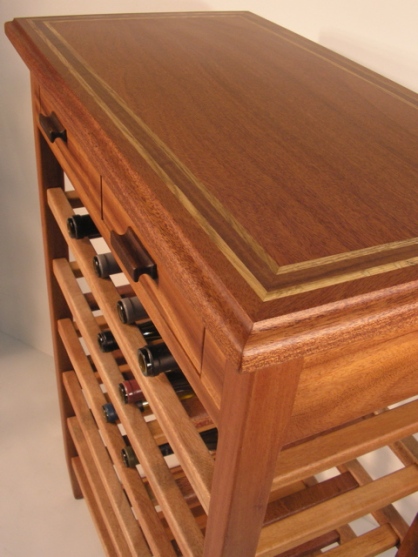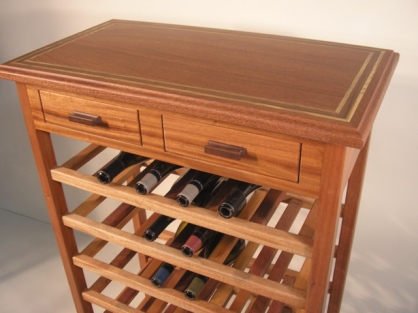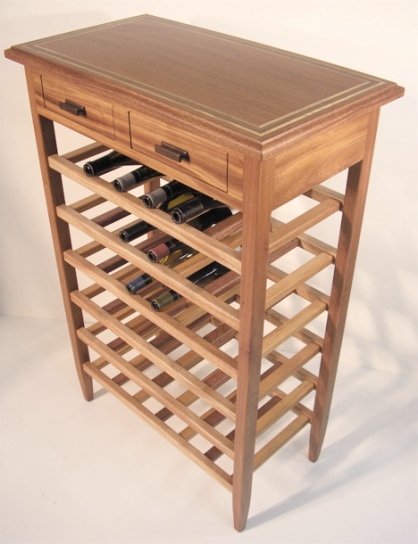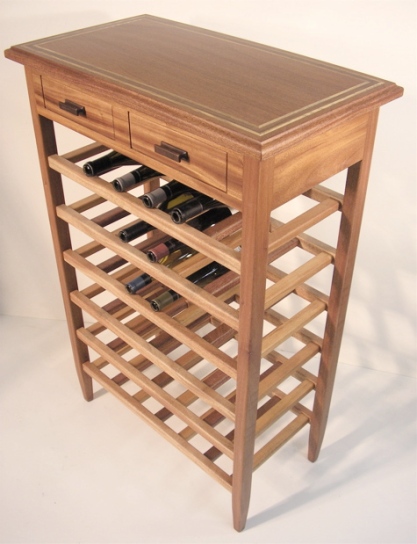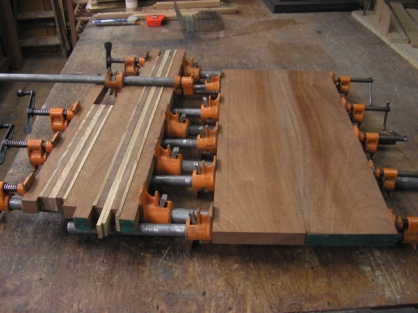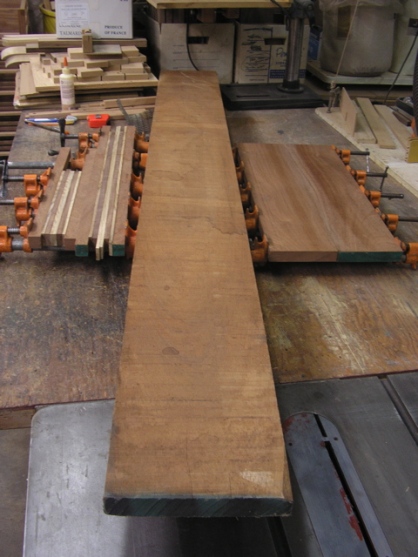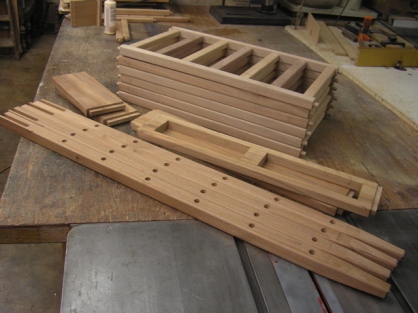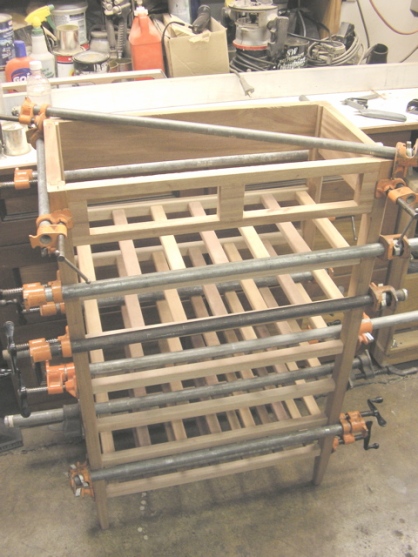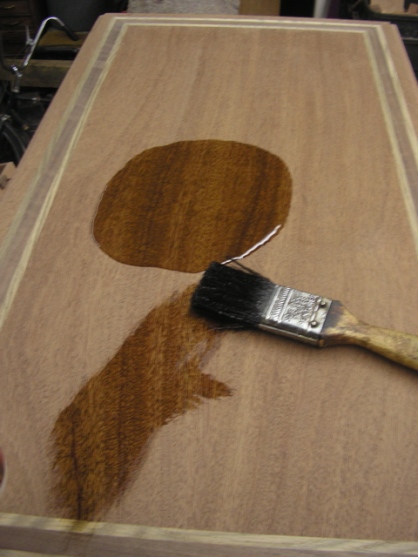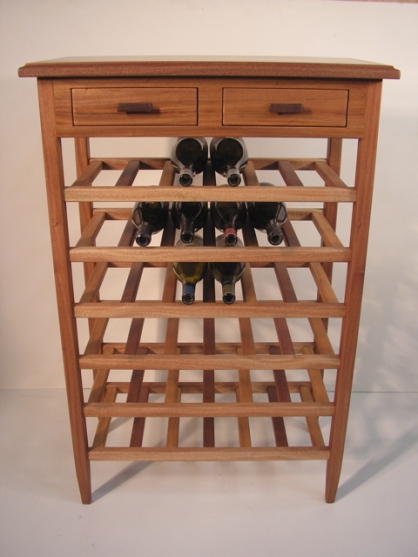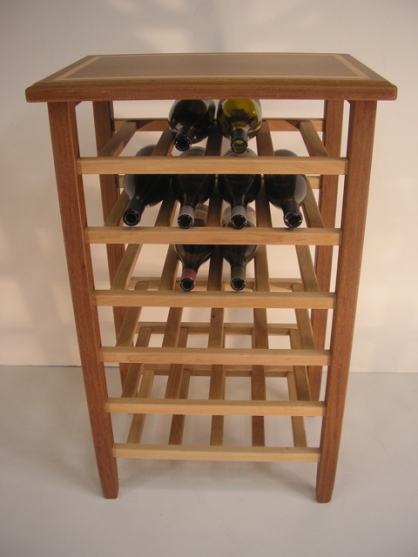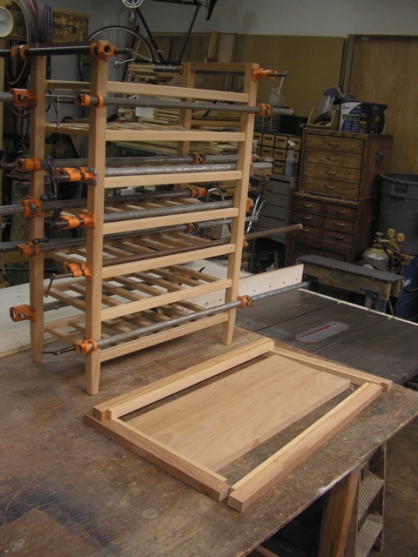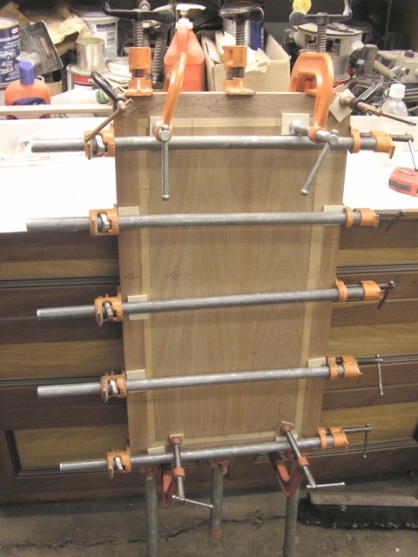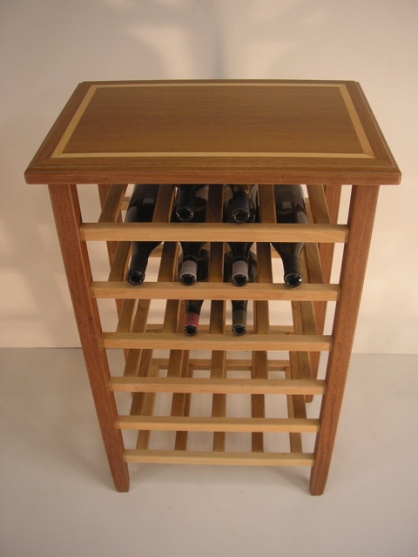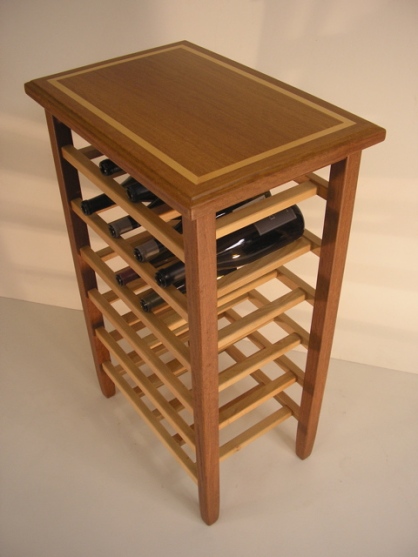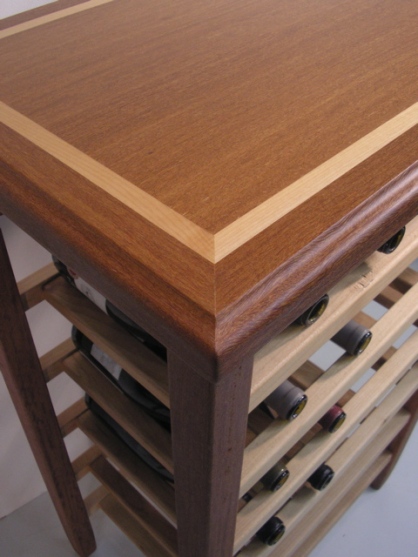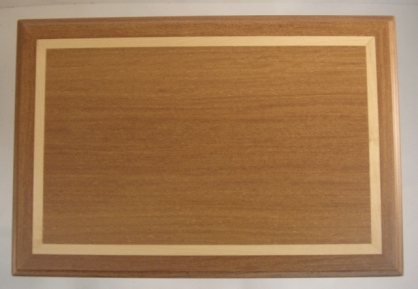The Ultimate Father’s Day Gift!
May 24, 2011
I have to post some more photographs of KTW#6011. Usually by the time I get a piece into the finishing process I’m already thinking about which one of the projects I have sketched and gathered material for to start next. For some reason this piece really makes me smile when I see it. With the stripes in the grain through the drawer carcase, it looks somehow alive.
I’m not so in love with it that I want it. First of all, I can’t afford to own my stuff. Second of all, I have a cool wine rack that I made from White Oak and Black Walnut a few years ago. It is much like this one with the two drawers, but a little smaller, holding 25 bottles. We have only had it full once. Mostly we only have a few bottles on hand, using the shelves to sort the newspaper and magazines. Then they are available to read when we eat, but can have a place to get that stuff off the table. We are Knot very hardcore drinkers.
I spent so much energy, literally blood, sweat and tears building it, that I can’t see getting enough money to part with it. This wine table on the other hand needs to go to a good home. Hopefully to live it’s life in a beautifully furnished kitchen, dining room or even a wine cellar.
My process is being refined with every piece I construct. I’m getting a lot faster and better all the time.
It still takes me an enormous amount of time to make these racks, and there is an element of risk in each step of the process. I just chopped up a table that has been sitting on a shelf for a few years gathering dust. I got 90% into it and made a mistake that I couldn’t recover from. Whoops.
The most difficult thing for me right now is finding nice material and enough material to make at least one individual piece. So far, so good. This Khaya wood looks so elegant. I have enough to make one more like this. I don’t know what I will do with it. I could save it and use it in contrast with other woods.
I think about design all the time. All kinds of design in all kinds of disciplines and media. Woodworking uses a similar kind vocabulary as playing improvised musics, say straight ahead Jazz or Be-Bop. There may be no lyrics, but still there is a kind of universal transference of feeling and emotion through melody, harmony and rhythm.
Working with hardwoods gives that same kind of opportunity for use as a kind of visual vocabulary. There is a kind of visceral transference of energy that happens too, because at one time these objects were alive and growing.
My hands have touched every single surface of this piece many, many times. In the end, I love being able to touch it and have it feel soft and smooth. I want the drawers to have just the right amount of slide and feel to them. I want to look forward to putting my fingers on the drawer pulls, because they feel right.
I could see this in a beach house or ski cabin, with some nice bottles of red parked there for those weekends that make the years memorable.
Your Wine Cellar Needs Another Wine Rack!
May 20, 2011
Here is another floor standing wine rack made from the Khaya (known also as African Mahogany). It’s a 6 X 6, six bottles wide and six racks tall, for three cases worth. The dimensions are 28″ x 15 1/2″ x 42″ tall.
Below: I have glued up contrasting edge band material and crosscut a board, then folded the board back on itself at the cut and glued it up for the field of the top.
There is a woodworking blog that I follow…
http://larrysworkshop.wordpress.com/
Lazy Larry has some very cool ideas about laminating different woods and creating interesting 3D patterns. I decided to start simply and use some of his basic ideas to create my table tops. Above: you see I have ripped some thin strips of White Oak from my dwindling stash that was dried from a fallen tree over on SW Crestwood Lane. I sandwiched a wider strip of Black Walnut, then glued them up with a wide strip of Khaya to form the edge band.
I’m not a very good photographer. I’m of the… take tons of pics… and hope some turn out OK, school of photography. Most of the time. I’m paying attention to what I’m trying to do in the shop, and forget to take shots as I go along in the process of building. Too many times I have stopped to take a photo, been side tracked, only to make mistakes because I forget what I’m doing. I hate that.
Next I milled up the board in the middle here for the legs, rack parts, carcase and drawers…
If I actually took photos of all the individual steps I go through, there would be hundreds of pictures. Unless you are into woodworking, it would be overkill, but I’m just trying to illustrate how many steps there are to making these things… how many steps there are for potential mistakes!
With every new project, I try to refine my ideas and processes, to be faster and still have a shot at quality.
Many woodworkers hate the finishing process. Some do great joinery only to apply bad finishes. I actually like applying finishes and with each piece, I add to my knowledge and experience. Still, it’s like shooting dice and no matter how hard you try there are potential problems. The experts know how to avoid problems and how to fix mistakes and any pitfalls that might occur. Most finishing materials are perishable products and you get one shot at it. Quality finishes are like shooting at a moving target… it’s difficult but not impossible.
Applying a finish is the payoff for me. After I have milled all the parts cleanly and glued everything up square and true, then sanded like crazy… seeing the grain pop out is like opening a present.
Lazy Larry’s lamination idea turned out really cool. I like it. I love the little ripples or “quilting” in the Black Walnut feature strip. There could be so many variations on this concept, I can hardly wait to try some more complex ideas.
More to follow…
Wine Tables, Wine Racks, Made In Oregon!
May 2, 2011
This rack was made from Machiche a very dense, hard, tropical lumber from Central America (sometime called Black cabbage-bark). The racks and feature strips in the mitered edge band on the tops is Alder from Oregon.
The dimensions are 23 1/2″ wide, 15 1/2″ deep and 37″ tall. The field here for the top was assembled from a piece of lumber that was cross-cut in two and folded back on itself. The edge band was cut from the same board so the color would remain consistent.
This Machiche is very hard and seems kind of brittle too, but it also seems dimensionally stable, resistant to expansion and contraction due to changing moisture in the air.
The grain is very beautiful. It’s subtle because at a distance it just seems to have a rich dark color, but up close the grain has a wonderful curly pattern.
The top turned out great. The glue joint is virtually invisible. It’s so cool when things turn out better or different from the way I envisioned them. I think the contrast with the light Alder wood turned out great. I love it when wood seems to have a golden glow to it.
I try as hard as I can to make each piece as well as I can. But still I make small mistakes and I’m working wood with it’s own challenges. No matter how much time or effort I put forth, things are never perfect, so I just do my best, work as quickly as I can, and try to get my kicks making different stuff from what ever material comes my way.
I always expect things to go wrong, because they already have so many times throughout each step of the process. Sometimes, I walk into the shop the morning after applying the final coat of clear finish the night before, and look at my pieces with kind of a detached amazement. Then it all comes back to me… oh yeah that was some idea I had way last month. I looked at some boards and thought I should see what would happen if I did this or that.
It’s great when I can think to myself… that turned out pretty good. So now, #0511 needs a good home and worthy bottles of wine to proudly display!
